Connelly Barnes
ZipIR: Latent Pyramid Diffusion Transformer for High-Resolution Image Restoration
Apr 11, 2025Abstract:Recent progress in generative models has significantly improved image restoration capabilities, particularly through powerful diffusion models that offer remarkable recovery of semantic details and local fidelity. However, deploying these models at ultra-high resolutions faces a critical trade-off between quality and efficiency due to the computational demands of long-range attention mechanisms. To address this, we introduce ZipIR, a novel framework that enhances efficiency, scalability, and long-range modeling for high-res image restoration. ZipIR employs a highly compressed latent representation that compresses image 32x, effectively reducing the number of spatial tokens, and enabling the use of high-capacity models like the Diffusion Transformer (DiT). Toward this goal, we propose a Latent Pyramid VAE (LP-VAE) design that structures the latent space into sub-bands to ease diffusion training. Trained on full images up to 2K resolution, ZipIR surpasses existing diffusion-based methods, offering unmatched speed and quality in restoring high-resolution images from severely degraded inputs.
Layer- and Timestep-Adaptive Differentiable Token Compression Ratios for Efficient Diffusion Transformers
Dec 22, 2024Abstract:Diffusion Transformers (DiTs) have achieved state-of-the-art (SOTA) image generation quality but suffer from high latency and memory inefficiency, making them difficult to deploy on resource-constrained devices. One key efficiency bottleneck is that existing DiTs apply equal computation across all regions of an image. However, not all image tokens are equally important, and certain localized areas require more computation, such as objects. To address this, we propose DiffRatio-MoD, a dynamic DiT inference framework with differentiable compression ratios, which automatically learns to dynamically route computation across layers and timesteps for each image token, resulting in Mixture-of-Depths (MoD) efficient DiT models. Specifically, DiffRatio-MoD integrates three features: (1) A token-level routing scheme where each DiT layer includes a router that is jointly fine-tuned with model weights to predict token importance scores. In this way, unimportant tokens bypass the entire layer's computation; (2) A layer-wise differentiable ratio mechanism where different DiT layers automatically learn varying compression ratios from a zero initialization, resulting in large compression ratios in redundant layers while others remain less compressed or even uncompressed; (3) A timestep-wise differentiable ratio mechanism where each denoising timestep learns its own compression ratio. The resulting pattern shows higher ratios for noisier timesteps and lower ratios as the image becomes clearer. Extensive experiments on both text-to-image and inpainting tasks show that DiffRatio-MoD effectively captures dynamism across token, layer, and timestep axes, achieving superior trade-offs between generation quality and efficiency compared to prior works.
Distilling Diffusion Models into Conditional GANs
May 09, 2024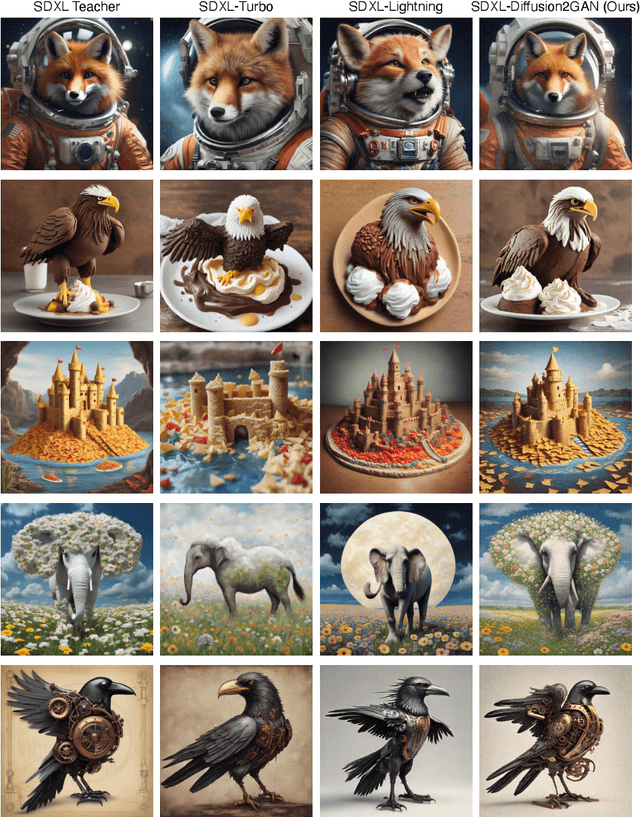

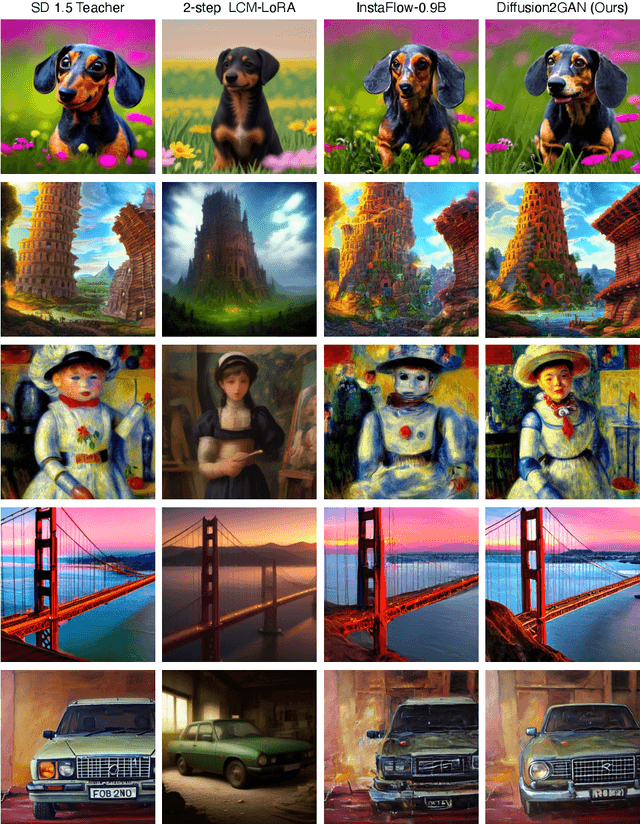
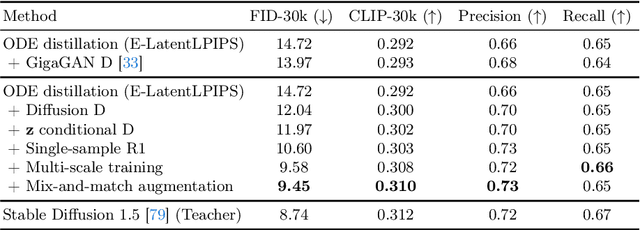
Abstract:We propose a method to distill a complex multistep diffusion model into a single-step conditional GAN student model, dramatically accelerating inference, while preserving image quality. Our approach interprets diffusion distillation as a paired image-to-image translation task, using noise-to-image pairs of the diffusion model's ODE trajectory. For efficient regression loss computation, we propose E-LatentLPIPS, a perceptual loss operating directly in diffusion model's latent space, utilizing an ensemble of augmentations. Furthermore, we adapt a diffusion model to construct a multi-scale discriminator with a text alignment loss to build an effective conditional GAN-based formulation. E-LatentLPIPS converges more efficiently than many existing distillation methods, even accounting for dataset construction costs. We demonstrate that our one-step generator outperforms cutting-edge one-step diffusion distillation models - DMD, SDXL-Turbo, and SDXL-Lightning - on the zero-shot COCO benchmark.
Perceptual Artifacts Localization for Image Synthesis Tasks
Oct 09, 2023



Abstract:Recent advancements in deep generative models have facilitated the creation of photo-realistic images across various tasks. However, these generated images often exhibit perceptual artifacts in specific regions, necessitating manual correction. In this study, we present a comprehensive empirical examination of Perceptual Artifacts Localization (PAL) spanning diverse image synthesis endeavors. We introduce a novel dataset comprising 10,168 generated images, each annotated with per-pixel perceptual artifact labels across ten synthesis tasks. A segmentation model, trained on our proposed dataset, effectively localizes artifacts across a range of tasks. Additionally, we illustrate its proficiency in adapting to previously unseen models using minimal training samples. We further propose an innovative zoom-in inpainting pipeline that seamlessly rectifies perceptual artifacts in the generated images. Through our experimental analyses, we elucidate several practical downstream applications, such as automated artifact rectification, non-referential image quality evaluation, and abnormal region detection in images. The dataset and code are released.
SimpSON: Simplifying Photo Cleanup with Single-Click Distracting Object Segmentation Network
May 28, 2023Abstract:In photo editing, it is common practice to remove visual distractions to improve the overall image quality and highlight the primary subject. However, manually selecting and removing these small and dense distracting regions can be a laborious and time-consuming task. In this paper, we propose an interactive distractor selection method that is optimized to achieve the task with just a single click. Our method surpasses the precision and recall achieved by the traditional method of running panoptic segmentation and then selecting the segments containing the clicks. We also showcase how a transformer-based module can be used to identify more distracting regions similar to the user's click position. Our experiments demonstrate that the model can effectively and accurately segment unknown distracting objects interactively and in groups. By significantly simplifying the photo cleaning and retouching process, our proposed model provides inspiration for exploring rare object segmentation and group selection with a single click.
Automatic High Resolution Wire Segmentation and Removal
Apr 01, 2023



Abstract:Wires and powerlines are common visual distractions that often undermine the aesthetics of photographs. The manual process of precisely segmenting and removing them is extremely tedious and may take up hours, especially on high-resolution photos where wires may span the entire space. In this paper, we present an automatic wire clean-up system that eases the process of wire segmentation and removal/inpainting to within a few seconds. We observe several unique challenges: wires are thin, lengthy, and sparse. These are rare properties of subjects that common segmentation tasks cannot handle, especially in high-resolution images. We thus propose a two-stage method that leverages both global and local contexts to accurately segment wires in high-resolution images efficiently, and a tile-based inpainting strategy to remove the wires given our predicted segmentation masks. We also introduce the first wire segmentation benchmark dataset, WireSegHR. Finally, we demonstrate quantitatively and qualitatively that our wire clean-up system enables fully automated wire removal with great generalization to various wire appearances.
Structure-Guided Image Completion with Image-level and Object-level Semantic Discriminators
Dec 13, 2022Abstract:Structure-guided image completion aims to inpaint a local region of an image according to an input guidance map from users. While such a task enables many practical applications for interactive editing, existing methods often struggle to hallucinate realistic object instances in complex natural scenes. Such a limitation is partially due to the lack of semantic-level constraints inside the hole region as well as the lack of a mechanism to enforce realistic object generation. In this work, we propose a learning paradigm that consists of semantic discriminators and object-level discriminators for improving the generation of complex semantics and objects. Specifically, the semantic discriminators leverage pretrained visual features to improve the realism of the generated visual concepts. Moreover, the object-level discriminators take aligned instances as inputs to enforce the realism of individual objects. Our proposed scheme significantly improves the generation quality and achieves state-of-the-art results on various tasks, including segmentation-guided completion, edge-guided manipulation and panoptically-guided manipulation on Places2 datasets. Furthermore, our trained model is flexible and can support multiple editing use cases, such as object insertion, replacement, removal and standard inpainting. In particular, our trained model combined with a novel automatic image completion pipeline achieves state-of-the-art results on the standard inpainting task.
Inpainting at Modern Camera Resolution by Guided PatchMatch with Auto-Curation
Aug 06, 2022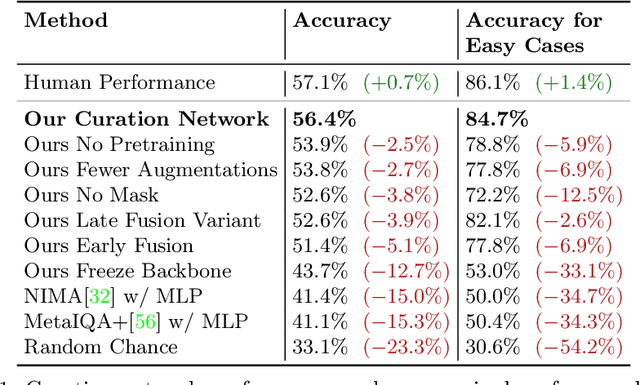
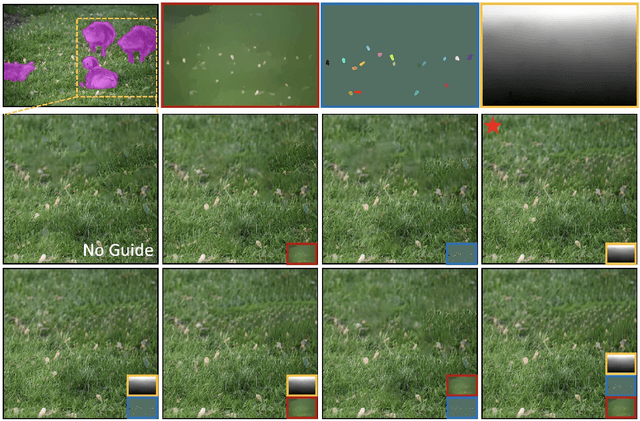


Abstract:Recently, deep models have established SOTA performance for low-resolution image inpainting, but they lack fidelity at resolutions associated with modern cameras such as 4K or more, and for large holes. We contribute an inpainting benchmark dataset of photos at 4K and above representative of modern sensors. We demonstrate a novel framework that combines deep learning and traditional methods. We use an existing deep inpainting model LaMa to fill the hole plausibly, establish three guide images consisting of structure, segmentation, depth, and apply a multiply-guided PatchMatch to produce eight candidate upsampled inpainted images. Next, we feed all candidate inpaintings through a novel curation module that chooses a good inpainting by column summation on an 8x8 antisymmetric pairwise preference matrix. Our framework's results are overwhelmingly preferred by users over 8 strong baselines, with improvements of quantitative metrics up to 7.4 over the best baseline LaMa, and our technique when paired with 4 different SOTA inpainting backbones improves each such that ours is overwhelmingly preferred by users over a strong super-res baseline.
Perceptual Artifacts Localization for Inpainting
Aug 05, 2022Abstract:Image inpainting is an essential task for multiple practical applications like object removal and image editing. Deep GAN-based models greatly improve the inpainting performance in structures and textures within the hole, but might also generate unexpected artifacts like broken structures or color blobs. Users perceive these artifacts to judge the effectiveness of inpainting models, and retouch these imperfect areas to inpaint again in a typical retouching workflow. Inspired by this workflow, we propose a new learning task of automatic segmentation of inpainting perceptual artifacts, and apply the model for inpainting model evaluation and iterative refinement. Specifically, we first construct a new inpainting artifacts dataset by manually annotating perceptual artifacts in the results of state-of-the-art inpainting models. Then we train advanced segmentation networks on this dataset to reliably localize inpainting artifacts within inpainted images. Second, we propose a new interpretable evaluation metric called Perceptual Artifact Ratio (PAR), which is the ratio of objectionable inpainted regions to the entire inpainted area. PAR demonstrates a strong correlation with real user preference. Finally, we further apply the generated masks for iterative image inpainting by combining our approach with multiple recent inpainting methods. Extensive experiments demonstrate the consistent decrease of artifact regions and inpainting quality improvement across the different methods.
Deep 360$^\circ$ Optical Flow Estimation Based on Multi-Projection Fusion
Jul 27, 2022



Abstract:Optical flow computation is essential in the early stages of the video processing pipeline. This paper focuses on a less explored problem in this area, the 360$^\circ$ optical flow estimation using deep neural networks to support increasingly popular VR applications. To address the distortions of panoramic representations when applying convolutional neural networks, we propose a novel multi-projection fusion framework that fuses the optical flow predicted by the models trained using different projection methods. It learns to combine the complementary information in the optical flow results under different projections. We also build the first large-scale panoramic optical flow dataset to support the training of neural networks and the evaluation of panoramic optical flow estimation methods. The experimental results on our dataset demonstrate that our method outperforms the existing methods and other alternative deep networks that were developed for processing 360{\deg} content.
 Add to Chrome
Add to Chrome Add to Firefox
Add to Firefox Add to Edge
Add to Edge